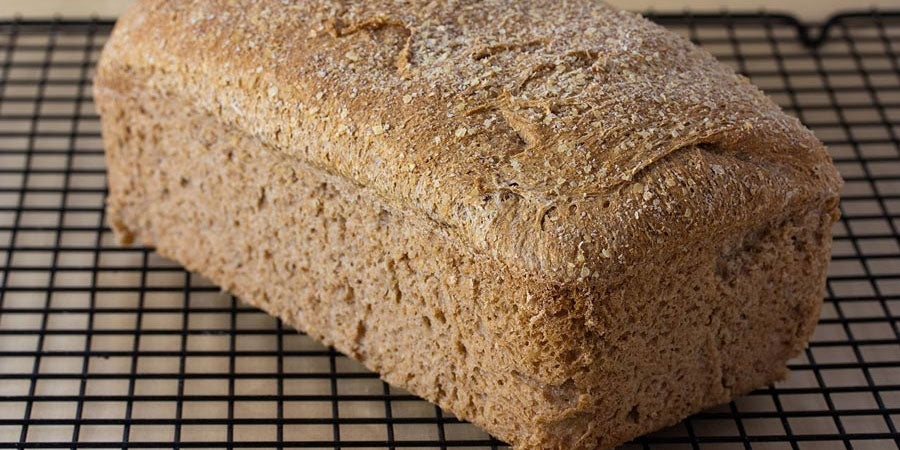
There is nothing that strikes fear in the hearts of dieters worldwide like white bread! When talking to those looking to lose fat, one of the first things dieters will usually tell you is that they cut out bread. Some make the switch over to whole-grain bread, while others cut it out altogether.
Is bread really that bad for fat loss? Is whole grain bread a better option for those looking to lose weight? As it turns out, the answer is not so black and white, or brown and white, rather.
What Exactly Is “Whole-Grain” Bread?
To determine whether whole-grain bread is a good choice when compared to its notorious rival, white bread, we must consider what whole-grain bread is. The USDA dietary guidelines recommend that we consume at least half of the grains we eat as whole grains (1), but what exactly is a “whole-grain” food?
Although we may actually lack a reliable definition of whole-grain foods, the AACCI definition states that whole grains themselves are “intact, ground, cracked or flaked fruit of the grain whose principal components, the starchy endosperm, germ and bran, are present in the same relative proportions as they exist in the intact grain” (3). The USDA recommends a high intake of whole grains because they retain dietary fiber, iron, and B vitamins that are lost in the milling process of refined grains. Even in enriched refined grains that have had certain B vitamins and iron added back in, the fiber content is still decreased.
According to Ferruzzi et al., “there has been no universal standard of what constitutes a ‘whole-grain food,’” which has contributed to labeling inconsistencies and consumer confusion (2). So what do we know about whole-grain foods, and why does the USDA recommend such a high consumption rate? Without a universal standard, it’s no wonder why so many people are confused about what whole-grain foods even are, let alone their proposed benefits.
Greater Satiety?
Because whole-grain bread is absorbed at a slower rate than white bread, whole-grain bread is much more efficient at moderating blood glucose levels. The bran and the germ are removed from grains during the refining process of white flour, so white bread not only has far less nutrients, but it is also absorbed much quicker, resulting in increased blood glucose levels as compared with those resulting from whole-grain bread consumption. The quick absorption of white bread and other refined carbohydrates can leave you feeling hungry. The body’s normal response to an increase in blood sugar levels is to release insulin, which helps to stabilize blood sugar levels but can also make you feel hungry and even tired. Consuming whole-grain bread, which has a lower glycemic index, can help to avoid this “insulin effect.”
Remember, though, that the issue is not black and white. In theory, whole-grain foods are nutrient-dense, fiber-rich foods. But whole-grain bread is not the same as the whole grains that were used to make the bread. From soil to sandwich, grains must be physically transformed, so that even if all of the nutrients are there, they are digested more rapidly than they would be if the grains themselves were consumed. Even if the correct proportions of the endosperm, germ, and bran are maintained, the physical transformation of the grains results in a product with a faster rate of gastric uptake and absorption. A traditional loaf of wheat bread made with flour has no intact grains, whereas specialty products could theoretically include up to 100% of grains in their recipes as intact grains. More intact grains mean more micronutrients and fiber, and more fiber means greater satiety.
Greater Fat Loss?
Just because whole-grain bread contributes to greater satiety does not necessarily mean that consumption of whole-grain bread contributes to greater fat loss. If all other variables in the diet remain the same, simply switching white bread for whole-grain bread WILL NOT lead to greater fat loss. Greater satiety is a short-term effect and does not always mean greater weight or fat loss (4). The “insulin effect” of high-glycemic carbohydrates mentioned earlier is not enough to alter carbohydrate and fat oxidation and body composition (5). Replacing high-glycemic carbohydrates with low-glycemic carbohydrates, then, is not enough to increase fat loss.
While intake of low-glycemic index (slow-absorbing) carbohydrates as part of a calorie-restricted diet has been shown to contribute to greater weight loss (6), the same results have not been shown for a low-glycemic diet that it is not calorie-restricted. In other words, it is possible that the low-calorie aspect of the diet, and not the low-glycemic index aspect of the diet, contributes to greater weight loss.
Many people assume that low-glycemic index foods are better for fat loss because these foods are lower in sugar or otherwise “healthier.” One of the problems with this way of thinking is that it assumes that fat loss and fat gain are dependent upon the glycemic index of foods. There is not enough evidence to support this claim. Rather, satiety and blood sugar levels are dependent upon the glycemic index of foods. Fat loss and fat gain, by contrast, are dependent upon one’s total energy intake over time. What matters is the overall picture of the diet and not one particular snapshot or slice of bread.
“Whole-Grain” ≠ Whole Grains
The concept of “whole-grain” bread is not as simple as the food industry or even as academia makes it seem. Scientific evidence highlights the difference in glycemic index between whole-grain bread and white bread, but research studies and food advertisements alike are less apt to compare whole-grain bread to less or equally processed foods. Drawing such a clear line between whole-grain bread and white bread might be overrated because whole-grain bread is typically a refined grain too, albeit not as refined as white bread. For instance, glycemic index differs between white and whole-grain bread, but Hannah et al. found no difference in glycemic response in sandwiches made with these breads (7).
Compared to whole grains themselves, whole-grain bread might actually be more beneficial with regard to bioavailability and digestibility (8), but when it comes to moderating blood glucose levels and achieving satiety, whole-grain bread is not actually the best choice. Kris Gunnars of Authority Nutrition claims, “whole wheat bread spikes blood sugar faster than candy bars” (9). As illustrated by this claim, the various processes of refining and otherwise manipulating foods from their natural forms make the issue much more complicated than whole-grain vs. white bread. Many foods that we consume have been refined or processed in some way. While the amount and type of processing can contribute to different glycemic indexes and nutrient content, the processing is actually not directly related to effects on fat loss or fat gain without taking into account overall caloric intake.
Slower absorption thus might not be a well-founded reason to recommend whole-grain bread for consumption, but whole-grain bread is certainly beneficial for other reasons, like its nutrient content, which can contribute to long-term health and disease prevention. As part of a healthy diet and lifestyle, consumption of whole-grain bread can contribute to a healthy weight, BMI, and waist circumference. At the same time, it should be recognized that potentially better alternatives exist regarding micronutrient and fiber content. I always mention to clients with a family history of diabetes or other health issues that whole grains like oats, quinoa, wheat, and barley are better choices for protecting against hyperglycemia and the onset of diabetes.
So What?
The takeaway point here is that even if whole-grain bread is “healthier” for certain reasons, eating white bread will not hinder your progress with fat loss. If you consume the same amount of calories and carbohydrates from whole-grain bread and white bread, then the unequal glycemic indexes, fiber, and micronutrient contents are not enough to hinder fat loss goals. The differences might be enough, however, to alter your satiety levels after you eat the bread. Someone who switches out all white bread for whole-grain bread expecting to lose more fat will be disappointed if the rest of his/her intake remains the same. In the end, the type of bread you consume will not matter and having bread at all will not hinder fat loss. The most important factors that will determine whether you lose fat will be far larger than what type of bread you eat. Things like total caloric intake, macronutrient ratios, and daily energy expenditure are the big picture items that will determine progress.
References
- Dietary Guidelines Advisory Committee. Scientific Report of the 2015 Dietary Guidelines Advisory Committee, 2015. Hyattsville, MD: US Department of Agriculture, 2015.
- Ferruzzi MG, Jonnalagadda SS, Liu S, Marquart L, McKeown N, Reicks M, Riccardi G, Seal C, Slavin J, Thielecke F, van der Kamp JW, Webb D. Developing a standard definition of whole-grain foods for dietary recommendations: summary report of a multidisciplinary expert roundtable discussion. Adv Nutr 2014;5:164-176.
- American Association of Cereal Chemists International. Whole grain definition. Cereal Foods World 1999;45:79.
- Rebello C, Greenway FL, Dhurandhar NV. Functional foods to promote weight loss and satiety. Curr Opin Clin Nutr Metab Care 2014;17(6):596-604.
- Díaz EO, Galgani JE, Aguirre CA. Glycaemic index effects on fuel partitioning in humans. Obes Rev 2006;7:219-226.
- Juanola-Falgarona M, Salas-Salvadó J, Ibarrola-Jurado N, Rabassa-Soler A, Diaz-López A, Guasch-Ferré M, Hernández-Alonso P, Balanza R, Bulló M. Effect of the glycemic index of the diet on weight loss, modulation of satiety, inflammation, and other metabolic risk factors: a randomized controlled trial. Am J Clin Nutr. 2014;100(1):27-35.
- Hannah B, Mallard S, Venn B. Glycemic differences between white and whole grain bread but no differences in glycemic response between sandwiches made with these breads, implications for dietetic advice. J Diabetes Metab 2014;5(11): 456 doi: 10.4172/2155- 6156.1000456.
- Slavin JL, Jacobs D, Marquart L. Grain processing and nutrition. Crit Rev Food 2001;21(1):49-66.
- Gunnars K. Why is bread bad for you? The shocking truth. Authority Nutrition 2015. Internet: http://authoritynutrition.com/why-is-bread-bad-for-you/ (accessed 27 March 2015).
Guest Author: Acadia Webber










